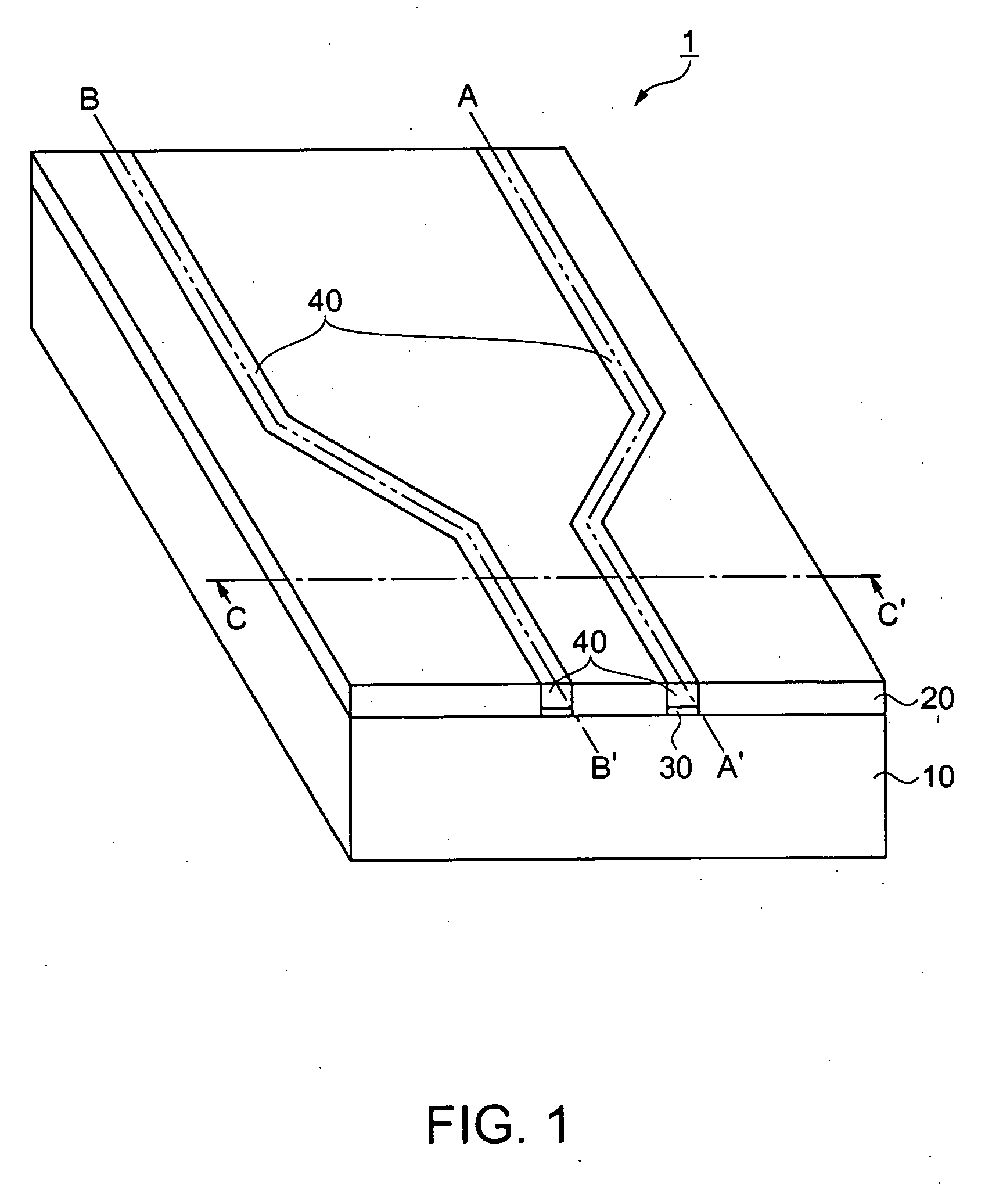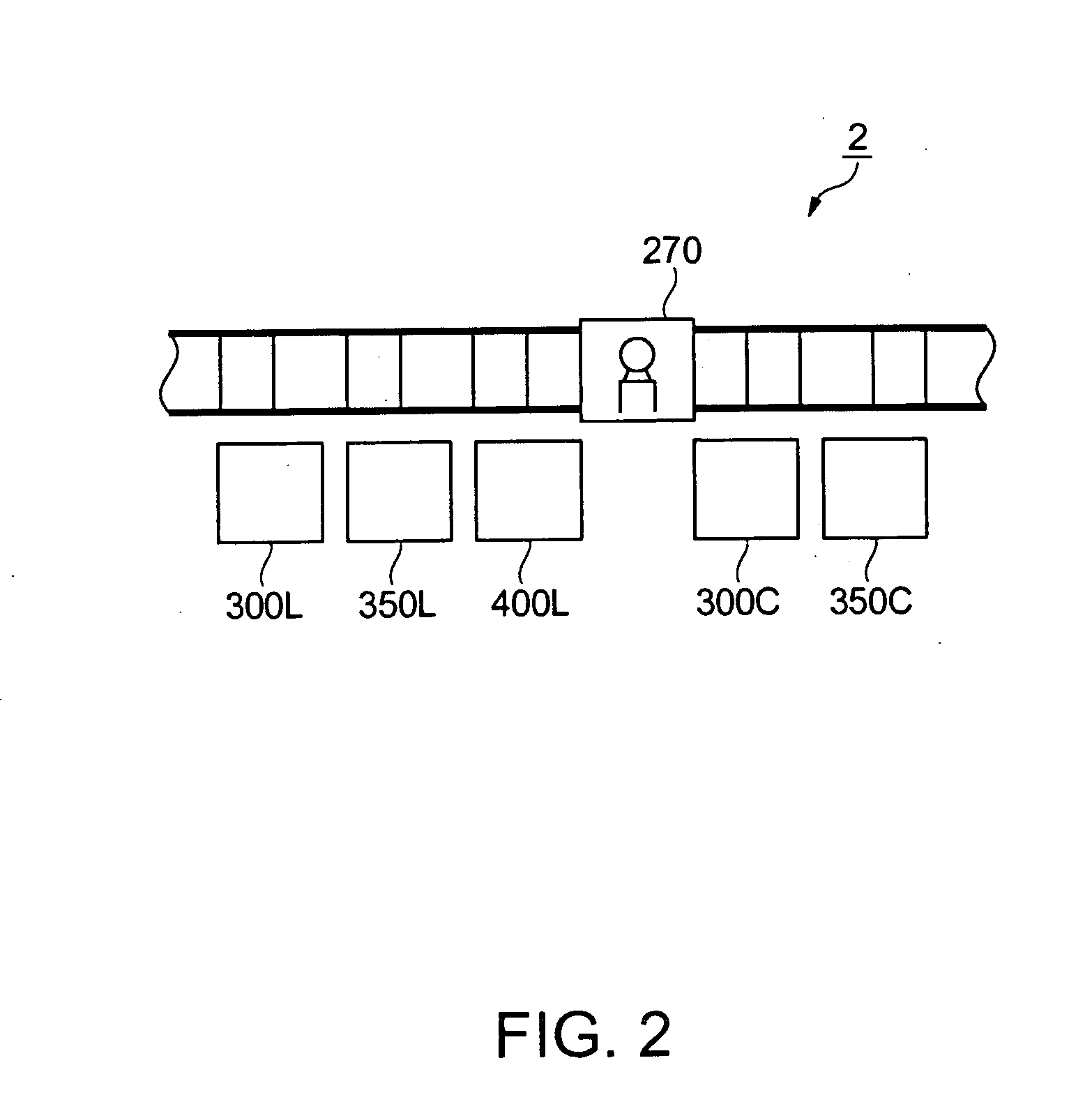Electric wire formation method, wiring substrate manufacturing method, electrooptical element manufacturing method, electronic apparatus manufacturing method, wiring substrate, electrooptical element, and electronic apparatus
a technology of electrooptical elements and wires, applied in the direction of resist details, coatings, printing, etc., can solve the problems of metal ink not evenly spreading at the bottom part, the lyophilic property of the bottom part cannot be relatively high to the bank pattern, etc., and achieve the effect of reliable lyophilic property
- Summary
- Abstract
- Description
- Claims
- Application Information
AI Technical Summary
Benefits of technology
Problems solved by technology
Method used
Image
Examples
first embodiment
[0049] Wiring Substrate
[0050]FIG. 1 is a perspective diagram of a wiring substrate 1 having electric wires formed by the electric wire formation method of the present embodiment. An X-Z plane located on a line C-C′ in FIG. 1 corresponds to a plane shown in FIG. 7B.
[0051] The wiring substrate 1 includes a support substrate 10 composed of polyimide, a bank pattern 20, a lyophilic layer 30, and a conductive layer 40. Here, both the bank pattern 20 and the lyophilic layer 30 are located on the support substrate 10. Further, the conductive layer 40 is located on the lyophilic layer 30. The bank pattern 20 is formed by processing an organic thin film composed of fluorine-containing organic molecules. More specifically, as the organic molecules, CF3CF2CF2CF2CF2CF2CF2CF2CH2CH2—Si(OCH3)3 which is a kind of a silane coupling agent is used. The bank pattern 20 containing such a material has liquid repellency against a hereinafter-described conductive material 40A (FIG. 7B). Further, the supp...
second embodiment
[0111] In the first embodiment, the lyophilic layer 30 is formed at the landing portion 50 after the bank pattern 20 is formed. In contrast, in the second embodiment, the bank pattern 20 is formed on the surface of the lyophilic layer 30 after the lyophilic layer 30 is applied to the entire surface of the support substrate 10. Except for this point, the second embodiment is basically the same as the first embodiment. Further, similarly to the foregoing descriptions, the wiring substrate 1, before being provided with the conductive layer 40, is expressed as the substrate 11.
[0112] First, the UV cleaning is conducted on the support substrate 10. Then, the support substrate 10 is moved to the stage 106 of the droplet ejection apparatus 300L by the transfer apparatus 270 inside the manufacturing equipment 2. Then, the droplet ejection apparatus 300L ejects the lyophilic material 30A from the ejection part 127 of the head 114 so as to form the layer of the lyophilic material 30A on the ...
third embodiment
[0123] In the first and second embodiments, the resist layer 20B applied for the formation of the bank pattern 20 is peeled off after the patterning of the organic resin thin film 20A and the resist layer 20B. However, it is possible to manufacture the electric wires without peeling off the resist layer 20B, if the resist layer 20B itself acquires the liquid repellency against the conductive material 40A. In the following, the third embodiment using such a method will be described.
[0124] The electric wire formation method of the third embodiment is identical to the electric wire formation method of the second embodiment, except for the elements as will be described below. Therefore, descriptions of the elements similar to those in the second embodiment will be omitted.
[0125]FIGS. 13A and 13B are diagrams illustrating the electric wire formation method of the embodiment. FIG. 13A shows the substrate 11 in a state in which, after providing the substrate 11 with lyophilic layer 30, t...
PUM
 Login to View More
Login to View More Abstract
Description
Claims
Application Information
 Login to View More
Login to View More - R&D
- Intellectual Property
- Life Sciences
- Materials
- Tech Scout
- Unparalleled Data Quality
- Higher Quality Content
- 60% Fewer Hallucinations
Browse by: Latest US Patents, China's latest patents, Technical Efficacy Thesaurus, Application Domain, Technology Topic, Popular Technical Reports.
© 2025 PatSnap. All rights reserved.Legal|Privacy policy|Modern Slavery Act Transparency Statement|Sitemap|About US| Contact US: help@patsnap.com



